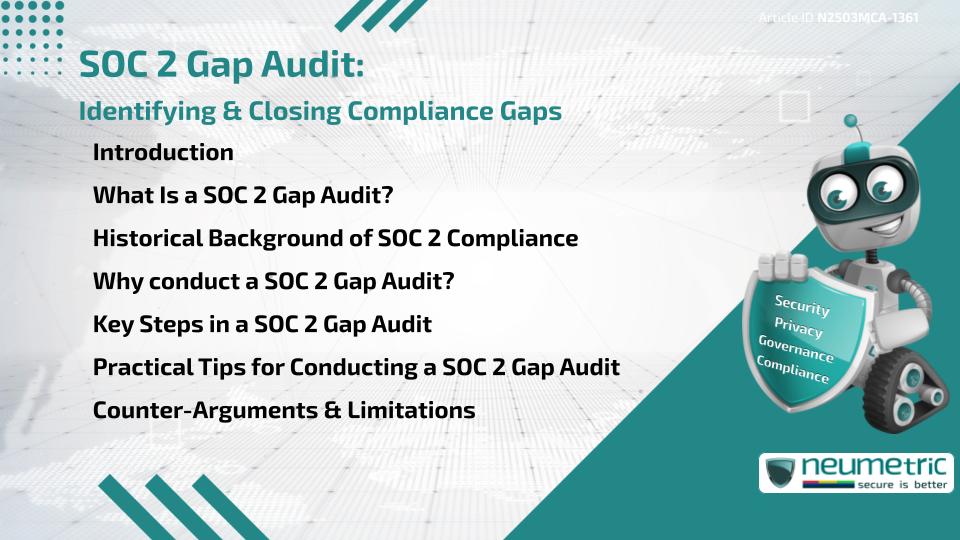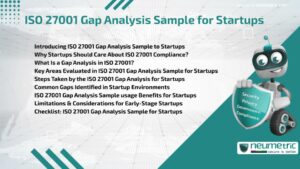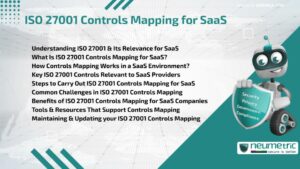Table of Contents
ToggleIntroduction
Achieving SOC 2 Compliance is a key goal for many organisations, especially those handling sensitive Customer Data. However, the journey to full compliance isn’t always straightforward. Many businesses struggle with gaps between their current practices & the requirements laid out by the American Institute of Certified Public Accountants [AICPA]. This is where a SOC 2 Gap Audit becomes crucial. A SOC 2 Gap Audit helps identify these gaps & provides a clear pathway for closing them, ensuring your company is on track for full compliance.
In this article, we will explore the importance of a SOC 2 Gap Audit, what it entails & how to effectively identify & address compliance gaps. We will also dive into the historical context of SOC 2, practical steps for conducting a Gap Audit & offer insights from diverse perspectives to ensure a well-rounded approach.
What Is a SOC 2 Gap Audit?
A SOC 2 Gap Audit is an internal or external review designed to identify any discrepancies between an organisation’s current practices & the requirements of the SOC 2 Framework. This Audit specifically focuses on the Trust Service Criteria [TSC] that relate to Security, Availability, Processing integrity, Confidentiality & Privacy.
During the Audit, Auditors examine an Organisation’s Security Policies, Practices & Controls to identify areas of Non-compliance. Once gaps are identified, a roadmap is created to address these issues, ensuring the company can achieve SOC 2 Compliance. The key benefit of this process is that it gives organisations a clear action plan to become fully compliant, mitigating potential risks down the line.
Historical Background of SOC 2 Compliance
SOC 2 was developed by the AICPA in response to growing concerns over Data Security & Privacy. In the early 2000s, with the increase in data breaches & growing regulatory pressures, businesses realised they needed a standardised way to prove their commitment to protecting Sensitive Data.
SOC 2 Audits became an essential tool for Service Organisations, particularly those in Technology & Cloud-based Industries. Unlike other Frameworks, SOC 2 focuses on evaluating controls over time, making it a more dynamic & comprehensive standard. Over the years, SOC 2 has become widely adopted as a benchmark for Information Security & Privacy Management, particularly for Businesses offering Cloud Services.
Why conduct a SOC 2 Gap Audit?
Risk Mitigation
The primary reason for conducting a SOC 2 Gap Audit is to mitigate potential risks. Gaps in your Security Controls can expose your company to Cyber Threats, Data Breaches & Non-compliance Penalties. By identifying these gaps early, you can implement Corrective Measures before they lead to costly consequences.
Improve Efficiency
A SOC 2 Gap Audit helps streamline compliance efforts. Instead of piecemeal solutions, a comprehensive Audit identifies all gaps in one go, allowing for more efficient resource allocation. This reduces redundant efforts & ensures that your Business focuses on the right areas.
Build Customer Trust
In today’s data-driven world, Customers are more concerned than ever about the security of their Personal Information. A SOC 2 Gap Audit provides transparency, showcasing your commitment to Security & Privacy. Demonstrating SOC 2 Compliance can significantly boost Customer trust and, in turn, improve your Business’s Reputation.
Key Steps in a SOC 2 Gap Audit
Step 1: Review of Current Controls
The first step in any SOC 2 Gap Audit is to review your existing Security & Privacy Controls. This involves gathering documentation such as your Information Security Policies, Access Controls, Risk Management strategies & any tools you use for data protection.
Step 2: Identify Gaps
Once the existing controls are reviewed, Auditors will assess whether these Controls meet the requirements set out by the SOC 2 Framework. If certain Practices or Policies do not align with the Trust Service Criteria, they will be flagged as gaps. These gaps could be related to outdated Security Protocols, insufficient monitoring or even lack of Employee Training on security practices.
Step 3: Develop a Remediation Plan
After identifying gaps, the next step is to create a Remediation Plan. This plan should outline specific actions to address each gap, with clear timelines, responsible parties & necessary resources. The remediation process may involve updating Security Controls, adopting new Technologies or improving Employee Awareness Programs.
Step 4: Implement Corrective Actions
With a Remediation Plan in hand, it is time to implement Corrective Actions. This may involve updating Software, conducting Staff Training Sessions or refining Data Handling Procedures. The goal is to close the gaps & align your company’s practices with SOC 2’s stringent requirements.
Step 5: Re-Assessment
After the Corrective Actions have been implemented, a Re-assessment should be conducted to ensure that the gaps have been effectively closed. This can be done through an Internal Audit or a follow-up Gap Audit by an external party. The Re-assessment ensures that the Corrective Actions have had the desired effect.
Practical Tips for Conducting a SOC 2 Gap Audit
- Start Early: Conduct your SOC 2 Gap Audit well in advance of your official SOC 2 Audit to allow enough time for remediation.
- Involve All Departments: SOC 2 Compliance affects multiple areas of your Organisation. Involve key Stakeholders from IT, Security, Operations & Legal Teams in the Gap Audit process.
- Focus on Documentation: A major part of SOC 2 Compliance involves having proper documentation for Security Policies, Procedures & Controls. Ensure all documentation is up-to-date & comprehensive.
- Regular Audits: SOC 2 Compliance is an ongoing effort. Conduct regular Gap Audits to ensure continuous adherence to the framework & to catch any new gaps that might arise.
Counter-Arguments & Limitations
While a SOC 2 Gap Audit is essential for identifying Compliance Gaps, some Organisations may feel overwhelmed by the complexity or resource demands of the Audit process. Small Businesses, in particular, may find it challenging to dedicate the necessary time or budget to conduct thorough Audits & implement Corrective Actions.
Moreover, it is important to recognise that passing a SOC 2 Audit does not guarantee absolute security. it simply means that an organisation’s practices align with the Trust Service Criteria at a specific point in time. Companies must continue to stay vigilant & adapt to evolving Security Threats.
Takeaways
- A SOC 2 Gap Audit helps identify gaps in an Organisation’s Security & Privacy Controls, providing a clear action plan to achieve Compliance.
- Conducting a Gap Audit early & often helps Mitigate Risks, streamline Compliance & build Customer trust.
- While resource-intensive, the SOC 2 Gap Audit is a vital step for Businesses aiming to demonstrate their commitment to Data Protection & Privacy.
FAQ
What is a SOC 2 Gap Audit?
A SOC 2 Gap Audit is a review of an Organisation’s current security practices to identify gaps in Compliance with the SOC 2 Framework’s Trust Service Criteria.
Why is a SOC 2 Gap Audit important?
It is important because it helps identify Vulnerabilities in Security Practices, mitigates risks & ensures that your organisation is on the right path to SOC 2 Compliance.
How often should a SOC 2 Gap Audit be conducted?
A SOC 2 Gap Audit should be conducted before a formal SOC 2 Audit & ideally on a regular basis to ensure continuous adherence to Security Best Practices.
What are the main Trust Service Criteria in SOC 2?
SOC 2 focuses on five (5) key Trust Service Criteria: Security, Availability, Processing integrity, Confidentiality & Privacy.
What is involved in a Remediation Plan after a SOC 2 Gap Audit?
A Remediation plan outlines specific Corrective Actions to address any gaps identified in the Gap Audit. This may include updating Policies, improving Security Controls or Training Employees.
Need help?
Neumetric provides organisations the necessary help to achieve their Cybersecurity, Compliance, Governance, Privacy, Certifications & Pentesting goals.
Organisations & Businesses, specifically those which provide SaaS & AI Solutions, usually need a Cybersecurity Partner for meeting & maintaining the ongoing Security & Privacy needs & requirements of their Clients & Customers.
SOC 2, ISO 27001, NIST, HIPAA, HECVAT, EU GDPR are some of the Frameworks that are served by Fusion – a centralised, automated, AI-enabled SaaS Solution provided by Neumetric.
Reach out to us!





